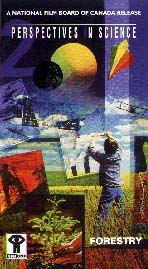|
________________
CM . . . .
Volume V Number 4 . . . . October 16, 1998
The purpose of this forestry video is to "explore diversity,
natural succession, energy flows, clonal propagation, soil
protection and ... on-going research into forest ecosystems," to
explore how logging companies implement "silviculture plans,
fisheries and wildlife protection strategies, site preparation,
harvesting operations and post harvest treatments," and finally
to look at alternatives to clear-cutting. It is organized into
five chapters - an initial drama which illustrates the dilemmas
facing modern forest managers, and four subsequent chapters
entitled "Discussion," "Analysis," "Perspectives" and
"Alternatives." Each of these is further subdivided into
"Science," "Technology", and "Society" segments.
The video is accompanied by a "Teacher's Guide," which I did not
have, but it is clear that the segments of this video are meant
to be used as starting points for more indepth study. Any
teacher wanting to use this video to anchor a forestry study
module would have to supplement it with other resources,
especially materials that would clarify many of the terms and
concepts mentioned in the video such as "vegetation management"
[a euphemism for the use of broadleaf herbicides].
The drama is awkward, but it does raise the most pertinent
questions surrounding the forest industry - is the short term
economic benefit of intensive logging worth the ecological cost,
and if not, are there realistic alternatives? The ensuing
sections provide students with enough scientific, technological,
and sociological background to at least begin to address these
fundamental questions.
The video covers an incredible number of relevant aspects of
forestry and does so from many viewpoints. Scientists,
Aboriginals, environmentalists, consultants, government
officials, conventional loggers, and horse loggers all offer
their perspectives and discuss their work and concerns. Since
there are so many of them and their views so dissimilar, this
video could be confusing if it is not methodically supplemented
with classroom discussion time.
Some of the most persuasive viewpoints are the "technology"
segments in which logging company employees demonstrate how they
systematically log and reforest. The "Society" segments, for the
most part, provide a good counterpoint to the persuasiveness of
the logging company claims. Unfortunately the weakest parts of
the videos are some of the "Science" segments, consisting of
professors discussing basic concepts at length. I had hoped that
the science segments would have shed some light on the
credibility of the claims both of the loggers and the
environmentalists.
In spite of the appearance of structure in the video, there is
actually little discussion or analysis. It consists mostly of
commentary of the "talking heads" variety, and visuals are rarely
tied directly to comments. Specific questions are not often
raised, and little attempt is made to answer questions or verify
any contending claims that are made. Although many issues are
discussed, it is up to the teacher or facilitator to identify the
questions which need addressing and to attempt to answer these
questions.
The highlight of the video is the horse logging segment which is
presented as an alternative to intensive clearcut logging. As
with the rest of the video, however, the viability of such a
logging system is not explored in any systematic way.
In spite of these shortcomings, I would recommend this video as
an excellent resource around which to build a comprehensive study
of forestry practices. Given the complexity of the topic, it is
best suited for high school students. Possible supplementary
resources include Elizabeth May's recent book, At the Cutting
Edge: The Crisis in Canada's Forest and Natural Resources
Canada's The State of Canada's Forests 1996-1997.
This video is close captioned. The two other videos in NFB's
Perspectives in Science 2 Series are entitled Soil and Air.
The three volume set is also available for $125.00 citing order number 193C 9197.
Recommended.
David Colborne is the librarian at Nova Scotia's Department of
Natural Resources.
To comment on this title or this review, send mail to cm@umanitoba.ca.
Copyright © the Manitoba Library Association.
Reproduction for personal use is permitted only if this copyright notice
is maintained. Any other reproduction is prohibited without
permission.
Published by
TABLE OF CONTENTS FOR THIS ISSUE - OCTOBER 16, 1998.
AUTHORS |
TITLES |
MEDIA REVIEWS |
PROFILES |
BACK ISSUES |
SEARCH |
CMARCHIVE |
HOME
|

